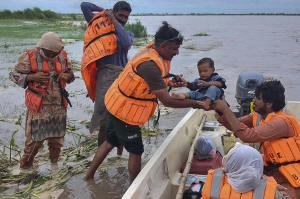Mass evacuations in eastern Pakistan as India releases water from
swollen rivers
[August 26, 2025]
By BABAR DOGAR and MUNIR AHMED
LAHORE, Pakistan (AP) ó Pakistan has evacuated tens of thousands of
people to safer areas after neighboring India released water from
overflowing dams and swollen rivers into low-lying border regions,
officials said Tuesday.
The move came a day after New Delhi alerted Islamabad about possible
cross-border flooding, marking the first public diplomatic contact
between the two nuclear-armed rivals in months.
Pakistanís National Disaster Management Authority said it had issued an
advance alert to its Punjabi counterparts about a surge in the Sutlej
River and the risk of flooding, and that evacuations from various
districts in the eastern Punjab province were underway.
In a statement, it said rescuers evacuated more than 14,000 people from
Kasur, a district in Punjab province, while over 89,000 were moved to
safer ground from the city of Bahawalnagar, near the Indian border.
The NDMA said authorities have urged residents to stay away from rivers,
streams and low-lying areas, avoid unnecessary travel, and follow alerts
issued through the media, mobile phones and the NDMAís disaster alert
app.
The latest flood alert and evacuation drive by Pakistan comes as heavy
monsoon rains continue to batter both South Asian countries.
In Pakistanís northwest, many residents complained this month that they
had received no warning before flash floods struck Buner district,
killing more than 300 people. Officials have said the devastation was
caused by a sudden cloudburst, which could not have been predicted, and
that many of the victims were living along natural water pathways.
Nationwide, floods triggered by seasonal rains have killed more than 800
people in Pakistan since June 26.

In Kashmir, which is split between the two sides and claimed by both in
its entirety, at least 65 have also died and hundreds have been
displaced in the Indian-administered Jammu area.
Many of the regionís rivers and tributaries eventually flow into
Pakistan and the part of Kashmir it controls. On Tuesday, Indian
officials said most rivers and streams were overflowing, with muddy
waters inundating homes in several places and damaging roads and
bridges. Water levels in multiple rivers continued to rise in the
region.
[to top of second column]
|

In this photo released by Pakistan's National Disaster Management
Authority, rescue workers evacuate villagers from a low-lying area
due to rising water level in the Sutlej River following neighbouring
India released water from overflowing dams, in Bahawalnagar a
district in Pakistan's Punjab province bordering India, Tuesday,
Aug. 26, 2025. (Pakistan's National Disaster Management Authority
via AP)

According to the Indian Meteorological Department, rains should
persist until late Tuesday.
In 2014, Kashmir saw its worst monsoon flooding in a century,
leaving 500 people dead across the region.
This week's flood alert was conveyed to Pakistan through diplomatic
channels rather than the Indus Waters Commission, the permanent
mechanism created under the 1960 World Bank-brokered Indus Waters
Treaty, which was suspended by New Delhi after the April killing of
26 tourists in Indian-controlled Kashmir.
Pakistan says India cannot scrap the treaty unilaterally. The treaty
had earlier survived two wars between the countries, in 1965 and
1971, and a major border skirmish in 1999. The suspension of treaty
and scaling down of diplomatic ties by India over the killing of
tourists eventually set off tit-for-tat missile strikes by the both
sides in May.
The exchange ended only after U.S. President Donald Trump announced
that he had brokered a ceasefire. Since then, the two sides have not
taken steps to normalize ties.
Pakistan in recent months has witnessed multiple cloudburst floods
and more than normal rainfall. Pakistanís annual monsoon season runs
from July through September.
Scientists and weather forecasters have blamed climate change for
heavier rains in recent years in the region. This year's heavy rains
have raised fears of a repeat of the 2022 downpour, also blamed on
climate change, that inundated a third of the country and killed
1,739 people.
___
Associated Press writer Aijaz Hussain contributed to this story from
Srinagar, India.
All contents © copyright 2025 Associated Press. All rights reserved |